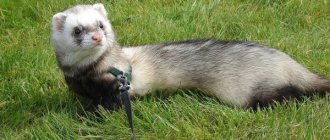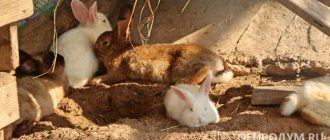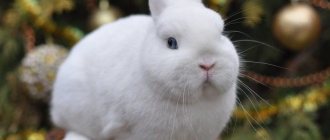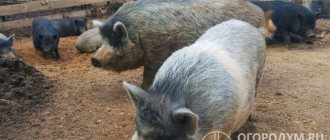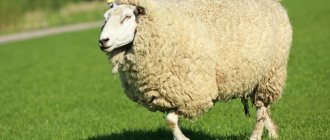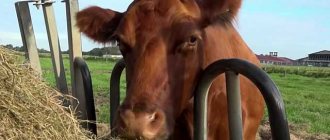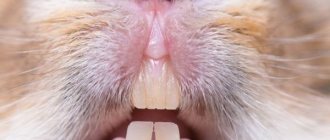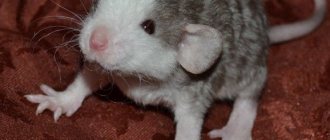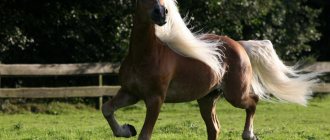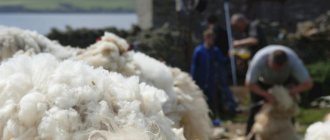Red-colored rabbits are far from uncommon today. They are found among different breeds. Due to its bright color, the red rabbit is popular as an ornamental species, but agricultural specimens are also found.
Red rabbits
Under natural conditions, they live in rocky areas. The main location is the mountain slopes in the south of the African continent. Sometimes they can be found in bushes or grass near the mountains, where males, females and their cubs rest and sleep.
These animals lead the most active lifestyle at night. The diet mainly consists of insects, cereals, leaves, and some fruits. They usually lead a solitary lifestyle, hiding in shelters during the day. Sometimes it was possible to see groups of red rabbits, which consisted of a female and her offspring.
Burgundy breed
Brought out by crossing Californian and New Zealand red breeds. Light brown color with a yellowish tint. The fur is short and quite hard to the touch. The red Burgundy rabbit is endowed with an elongated body and head, a wide chest and a short neck. The ears are small, straight, ending in a spoon. The muscles of the hind legs are especially developed in the area of the sacrum and lower back.
Representatives of the Burgundy species have excellent immunity. The average life expectancy is 10 years.
The Burgundy rabbit breed is one of the meat breeds. The average weight of one rabbit is 4-4.5 kg, and can reach 5 kg. The female gives birth to 8-12 rabbits, which grow quickly and by 4-5 months already have the weight of an adult.
Burgundy breed
general characteristics
Today there are 3 breeds, the main feature of which is the red color of their coat. They differ from each other in origin, size and position of the ears. This:
- Burgundy red rabbits;
- representatives of the New Zealand breed;
- red rabbit mini-ram (the main color of the breed is bright fiery).
Some veterinarians believe that red rabbits have a shorter life expectancy than any other breed, but this fact has not yet been scientifically confirmed.
New Zealand red rabbit
Appeared due to the crossing of Flanders with representatives of other breeds. They have a bright color: from yellow-red to red-brown. The body is cylindrical, the head is wide and short, the chest is also wide, the legs are short and thick.
Reaches 5 kg of weight, usually females are larger than males. Animals of the New Zealand species are prolific and not picky about growing conditions, so they are found on different continents. A distinctive feature of individuals is their resistance to extraneous noise and physical activity. The character is calm and friendly.
Tips for choosing
Regardless of color, rabbits are selected according to the same criteria:
- The animal must be strong and healthy, not show signs of disease, and not refuse food and water.
- If a purebred rabbit is purchased, it must have documents issued by a responsible breeder.
- It is worth purchasing pets from trusted people who professionally breed rabbits.
- A domestic rabbit should have a good character, a calm disposition, and no aggression. This is important if there is a small child or other pets in the house.
- You should not take large breed rabbits into a small apartment.
Compliance with the rules will help you purchase a healthy and cheerful rabbit, which will become a pet or bring strong offspring - a source of income.
Red ram
The peculiarity of this breed of rabbits is their hanging ears, the length of which reaches 55-70 cm with a width of 10-16 cm. They have thick, smooth fur of medium length, the legs are thick and short, and the chest is wide.
The Red Sheep species is unpretentious in cultivation and adapts to almost all climatic conditions. The weight of an adult animal varies from 5 to 8 kg, sometimes even reaching 10 kg. The meat is high quality and tasty.
Rabbit red ram
Rex
Rex was the result of a mutation of the Belgian giants, which gave birth to offspring with short hair. The name comes from the Latin word meaning "king". Rexes have short but thick plush fur. The body is elongated, the neck is strong. The head is elongated, with a wide forehead. The animals' ears are straight, stick up, and reach a length of 11–12 cm. The peculiarity of these animals is their short, curled mustache.
Thanks to thin bones, Rexes have low weight and high meat yield. The weight of an adult is 3–5 kg. Rexes can easily tolerate temperatures down to -30°C.
The disadvantages of Rex include:
- intolerance to high (from 25 degrees) temperature;
- slow growth and late maturation of cubs;
- low fertility (5–6 rabbits).
Angora saffron milk caps
There are similarities with downy Angora goats. The fur is long and airy, similar to fluff. Such a “fur coat” requires careful care; regular combing is indispensable. The fur hanging over the eyes should be trimmed periodically to avoid vision problems.
Angora saffron milk rabbits
The presented collection contains the most common types of eared saffron milk caps. The red rabbit has an attractive appearance, so it has become widespread. He settled in houses near people solely because of his good-natured and flexible nature.
Rules of maintenance and care
Animals need to be provided with comfortable and peaceful living conditions. The absence of high humidity and drafts is important for them. Housing should be warm and safe. Cleanliness is the main condition for animal health. Cages need to be cleaned regularly. Feeding on a schedule is also important because rabbits need frequent feeding.
Expert opinion
Zarechny Maxim Valerievich
Agronomist with 12 years of experience. Our best country expert.
Ask a Question
Animals are given balanced feed, always hard food (branches, grain, juicy root vegetables), and constant access to clean water.
If the rabbit will live in the house as a pet, it should have its own place away from open windows. Wires, valuables, and plants need to be removed from the apartment. The animal needs to be provided with water and food, limit contact with small children and create a calm environment, because rabbits are nervous creatures, and stress causes them to develop depression and illness.
Features of breeding for sale
Decorative rabbits give birth approximately 8 times a year, but this number may be less. Small breeds begin to reproduce at approximately 6-7 months.
The behavior of a female rabbit that is ready to breed changes dramatically - she rakes the litter into one place and begins to build a nest. For mating, the female is placed next to the rabbit (strictly - the opposite cannot be done).
It is recommended to leave her in the male’s cage for some more time for repeated matings, and then return her back to her house.
If the female is not ready to mate, she will thump her hind legs and simply behave aggressively. In this case, the animals are seated and wait for a more favorable moment.
After mating, a pregnant female, after a couple of weeks, when she joins the male, begins to behave unkindly and fights off. This is how they determine whether it is covered or not. The method is not 100%, since some pregnant females also like to mate.
You can carefully palpate the rabbit's body - small rabbits feel like balls. Under no circumstances put pressure on your stomach, especially not too much. Also, pregnant females often develop a voracious appetite. Birth occurs on average 31 days after covering. The baby rabbits are left in the cage with the mother - she feeds and licks them.
Diseases
Decorative rabbits can suffer from infectious and viral diseases. The main ones are rhinitis, stomatitis, staphylococcosis, otitis, conjunctivitis. The animals suffer from intestinal disorders, and the active growth of teeth causes them severe inconvenience. A complete list of diseases of decorative rabbits is presented in this material.
It is recommended that decorative rabbits receive vaccinations - and, believe me, they will cost you much less than further treatment.
Competent care and proper feeding will help to avoid diseases. Make sure that the animal’s diet is balanced, otherwise constant diarrhea cannot be avoided.
Stomach upset is caused by weevil-infected dry food, excess fruits and vegetables, moldy bread, sudden changes in feed, gastrointestinal diseases, unsanitary conditions, and viruses. A common occurrence is constipation. Read what to do if your rabbit is constipated here.
In case of diarrhea, you need to disinfect the cage and give the animal a decoction of chamomile. If it doesn't go away for a long time, contact your veterinarian.
Homemade
Representatives of domestic breeds of rabbits can be kept both outdoors (for meat and fur) and at home - in a special cage. Animals can freeze outside in cool weather.
The home cage is lined with sawdust or straw, which is changed regularly.
Animals are not allowed to walk around the apartment! It happily chews furniture upholstery, wires and other interior items. Rabbits of these breeds can be trained to defecate in a tray with a special filler.
Butterfly
This English breed was originally considered a decorative breed. Later representatives of the breed were crossed with Flanders and Viennese Blues. Hybrids are grown for their skins.
Adults have a compact body with a small head and short erect ears. Body length 56-58 centimeters. The chest and back are wide. The limbs are long.
The skeleton is strong with well-developed muscles. The fur is short and thick. The main color of the skin is white. A characteristic feature is the presence of black-brown spots. The nose, ears and scruff are black.
There is a dark stripe in the center of the back. Weight up to 4.5 kilograms or more. The female is fertile, bringing up to 8 babies in one litter.
Vienna blue
The result of crossing the Flanders and Moravian Blue breeds. This hybrid can be classified as an endangered species.
The body is folded proportionally. The head is neat with straight ears rounded at the ends. The back is wide. The body is medium in size with a rounded croup.
Limbs are straight and strong. The fur is thick, uniformly colored bluish-blue. The inner surface of the ears is light. Average weight 4.5 kilograms. The female gives birth to up to 9 babies in one litter. The breed is valued for its high fluff content - the skin is extremely delicate and soft.
Squirrel
In 1916, German specialists bred rabbits with extremely decorative, high-quality fur. It is thanks to its originality and quality that the breed acquired its name - Belka, due to its similarity with Aleutian squirrels. These animals were bred through repeated crossings of Havanna and Blue Vienna breeds.
Rabbits of this breed are bred mainly for their fur, although the breed is considered a meat-skin breed, the skins are of high quality, unusually colored and are widely in demand in the fur industry. The breed is poorly represented in our country and is mainly bred in Germany.
Among the advantages of this breed, the main ones are low demands on feed and fairly simple conditions of keeping and rearing. Rabbits of this breed adapt well to various weather conditions, they can even be kept outdoors, they are quite hardy and resistant to diseases of the species.
Tortoiseshells
The history of selection of tortoiseshell rabbits is unknown; they are very rare and, unfortunately, only among those who like to breed rare breeds of rabbits. The rabbit breeders who developed this breed were obviously aimed at obtaining beautiful skins, and only then for meat.
The tortoiseshell rabbit is of medium size, quite strong in constitution, and its body composition is expressed in correct proportions. It got its name because of the peculiar original color of its fur.
The color is yellow-reddish, but with a slightly pronounced reddish tint, reminiscent of the skin of a fox at the height of summer. An adult tortoiseshell rabbit gains weight up to 4.5 kilograms.
Mothers from tortoiseshell rabbits turn out wonderful, they are quite balanced and give a large amount of milk, the rabbits grow quickly and you don’t have to worry about their safety.
Keeping a tortoiseshell rabbit is not particularly difficult, since they are unpretentious and can easily tolerate even harsh climatic conditions when kept in outdoor cages.
High quality fur products are made from the skins of tortoiseshell rabbits and have an excellent natural appearance. All this has greatly raised the price bar for the fur of these animals.
Classification
The division of rabbits into breeds is very arbitrary. All representatives of this species are used by humans for meat and fur. They differ mainly in appearance.
There are more than 200 breeds in the world (according to some sources, up to 700). In our country, due to climatic conditions, only 20 of them are available.
The following breeds are distinguished:
- Decorative.
- Meat.
- Downy ones.
- Fur: with normal hair; long-haired.
Decorative
Breeds of decorative rabbits are dwarf animals, similar to domestic ones. Their distinctive feature is large eyes and short ears.
Among the decorative ones there are: lion-headed breed, dwarf rex, dwarf ram, dwarf fox and hermelin.
Lionhead
A cross between short-haired and fluffy animals gave rise to the Lionhead breed. The animals got their name due to the resemblance of the head to a lion's mane.
A thick mop of long hair covers the head and torso. The rest of the body is covered with short hair of various shades. The animals are small, their weight does not exceed 1.7 kg. They are easy to keep and care for.
Dwarf rex
Short-haired individuals whose skin color is similar to that of a beaver belong to the Dwarf Rex breed. The features of dwarfism appear much more clearly due to the short hairline.
They have underdeveloped, crooked whiskers, which is a sign of the purebred breed. The eyes are large, close to each other. Body length 50 cm, total weight – 1.4 kg. The color is different.
Dwarf ram
Animals of the dwarf ram breed can be called giants among dwarfs, which does not prevent them from having a calm and docile character. The body is massive, 24-27 cm long and weighing 1.5 kg.
The eyes are beautiful and big. The paws are of medium thickness, the small tail is pressed to the body. The skin is soft and silky. The color is varied. The peculiarity of this species is its hanging ears, similar to those of a lamb.
Pygmy fox
But the dwarf fox is rightfully considered the midget among dwarfs, because the mass of animals of this breed is only 1.3 kg. The animals have a changeable character, and their body seems to be covered with a hanging woolen cloak.
The coat color can be either light tones (white, silver) or more saturated (Havana, black, blue, yellow).
Hermelin
Cute decorative white pets with blue eyes represent the Hermelin breed. Their weight is within 1.5 kg, and in their appearance they resemble Persian cats.
Hermelines are stocky, tightly knit, with small, rounded, closely spaced ears, and the neck is invisible.
The front legs are short, the claws are colorless. The coat is thick and shiny. The animal does not require special attention during maintenance and care.
Dutch mini rabbit
The classic color of pets is considered white and black with colored circles around the eyes, on the ears and hind legs in the form of socks. There are about 20 shades of fur coat from light gray to tortoiseshell.
The average weight of an adult Dutch dwarf is about 1.5 kg. In this regard, a care cage is purchased with a size of 50*70 cm. It should be equipped with a place for sleeping and feeding. Food can be purchased in specialized stores, adding vegetables, fruits, hay or grass to it in the summer.
Flexible colored dwarf
A small rabbit looks like a dense ball with small ears, which weighs from 1 to 1.3 kg. His fur is thick, shiny, dense to the touch. There is no specific color, because the breed has about 50 shades. The most famous of them are Siamese, chocolate, Russian, blue, white guard and squirrel.
Colored dwarfs quickly adapt to their new home. They have a calm character, are not shy, allow themselves to be picked up and even stand on their hind legs to greet their owner. The manifestation of aggression indicates that the animal is in sexual heat.
Source
Meat
Meat breeds of rabbits are attractive for their precocity and unpretentiousness. Most of them are suitable for breeding at home. For their tender and tasty meat they are often called broiler.
California rabbit
Appeared as a result of crossing several European breeds.
Adults have a small head and a relatively short body. The ears are short (up to 11 cm) and stand upright. Nose with a pronounced hump. The eyes are red.
The croup is round and wide - this is where the fleshiest part of the body is located. The limbs are also short. The skeleton is thin and light. The muscles are well developed.
The fur is thick and short. Color white. The nose, ears, paws and tail are brown or black. Average weight is from 4 to 5 kilograms. They gain weight before the age of five months.
Females give birth to an average of 8 babies per litter. The breed is distinguished by its resistance to low and high temperatures. They are bred both in the northern regions and in the arid steppes.
Soviet chinchilla
Bred by crossing two breeds: the domestic White Giant and the French Chinchilla.
In adults, the body is compact with a rounded back. The head is medium in size with erect ears. The chest is wide, with a girth of 37-44 centimeters.
The body reaches a length of 67 to 70 centimeters. Limbs are strong and straight. Average weight 4-5 kilograms. Young individuals reach a weight of 4 kilograms by four months.
The fur is thick with dense undercoat. The color is dark gray with a blue tint.
The fur on the inside of the legs and belly is lighter. A characteristic feature is the uneven color of each guard hair (there is a transition from a dark gray shade at the bottom to silver-white at the top). The guide hairs at the ends are black.
In general, the fur has a moire color that shimmers in the light. Females bring 8 or more babies per litter. The breed is early maturing and hardy, not afraid of cold weather.
Black-brown rabbit
Brought out by crossing three breeds: the White Giant, the Flanders and the Viennese Blue.
The head is massive with long wide ears (up to 18 centimeters long). The chest is wide, with a circumference of 37 centimeters. Body up to 61 centimeters long.
The croup is rounded and fleshy. The limbs are long and thick. The fur is fluffy, with thick, characteristic black-brown hair. The fluff is bluish. The head and back are black.
The sides of the animal are unevenly colored. The average weight of an adult is from 5 to 7 kilograms. Females bring 8 or more babies per litter. The breed is valuable for its original color of skins.
White pannon
White Pannon rabbits are classified as a meat breed and a broiler breed. Thanks to special selection for crossing, this hybrid was first created in Hungary. Breeders took as a basis representatives of the white giant, New Zealand and Californian breeds.
Experts who were involved in breeding young rabbits for meat gave the new breed a fairly high rating.
Downy
Representatives of downy breeds are distinguished by long and thick fur. They are kept by both farmers and amateur rabbit breeders.
Angora down
Widely distributed in Europe. This includes many long-haired species.
The homeland of the main breed is Türkiye. It was from this country that animals were imported in the Middle Ages for sale in European cities. It was very popular among the nobility to keep such rabbits as pets.
In adults, the body is shortened and cylindrical in shape. The head is small with short ears. Average weight 3 kilograms. The color is the most varied.
The predominant colors are beige, gray and white. The fur is thick and very long (up to 25 centimeters). It is combed or cut. Haircuts are done once every three months. From one animal they get up to 200 grams of valuable fluff.
White down
It was obtained by domestic rabbit breeders in the last century through the selection of Angora breeds from Europe.
The animals are quite large, up to 54 centimeters long. Average weight 4 kilograms. The body shape is compact, round. Limbs are short. The ears are small.
The fur is up to 15 centimeters long and is elastic (not prone to matting). The female gives birth to up to 7 babies in one litter. The breed is maximally adapted to our climate.
Arctic foxes
The breed is the oldest among fur-bearing animals and is well known throughout the country. Rabbits are gray or dark gray with a live weight of up to 3 kg. Their down is elastic, of medium density, with a small amount of guard hair. One adult individual produces up to 200 grams of product per year.
Advantages of the breed:
- high fertility of females;
- low mortality of young animals;
- unpretentiousness in food;
- high immunity.
Arctic fox rabbits are most often kept in cages, which require careful care to deteriorate the quality of the fluff.
